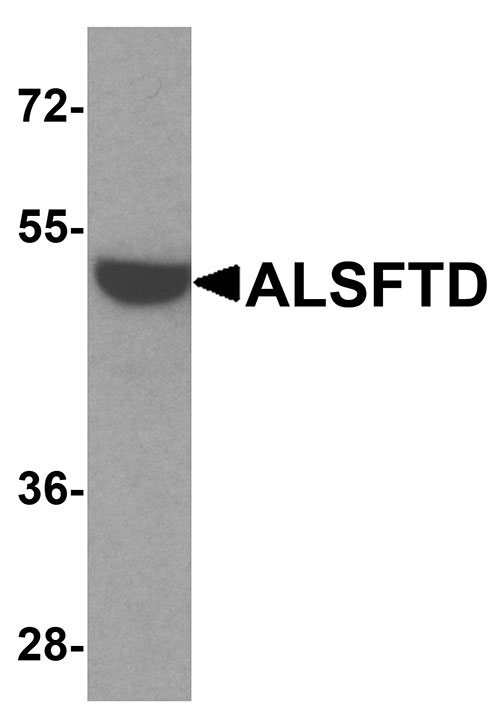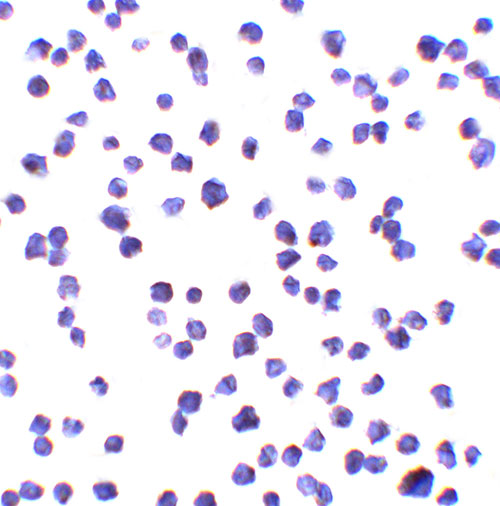ALSFTD Antibody
- SPECIFICATION
- CITATIONS
- PROTOCOLS
- BACKGROUND

Application
| WB, ICC, E |
|---|---|
| Primary Accession | Q96LT7 |
| Other Accession | NP_060795, 37039612 |
| Reactivity | Human, Mouse, Rat |
| Host | Rabbit |
| Clonality | Polyclonal |
| Isotype | IgG |
| Calculated MW | Predicted: 53 kDa Observed: 52 kDa |
| Application Notes | ALSFTD antibody can be used for the detection of ALSFTD by Western blot at 1 - 2 µg/mL. Antibody can also be used for immunocytochemistry at 10 µg/ml. |
| Gene ID | 203228 |
|---|---|
| Target/Specificity | ALSFTD; ALSFTD antibody is human, mouse and rat reactive. At least two isoforms are known to exist. |
| Reconstitution & Storage | ALSFTD antibody can be stored at 4℃ for three months and -20℃, stable for up to one year. |
| Precautions | ALSFTD Antibody is for research use only and not for use in diagnostic or therapeutic procedures. |
| Name | C9orf72 (HGNC:28337) |
|---|---|
| Function | Component of the C9orf72-SMCR8 complex, a complex that has guanine nucleotide exchange factor (GEF) activity and regulates autophagy (PubMed:27193190, PubMed:27103069, PubMed:27617292, PubMed:28195531, PubMed:32303654). In the complex, C9orf72 and SMCR8 probably constitute the catalytic subunits that promote the exchange of GDP to GTP, converting inactive GDP-bound RAB8A and RAB39B into their active GTP-bound form, thereby promoting autophagosome maturation (PubMed:27103069). The C9orf72-SMCR8 complex also acts as a regulator of autophagy initiation by interacting with the ULK1/ATG1 kinase complex and modulating its protein kinase activity (PubMed:27617292). As part of the C9orf72-SMCR8 complex, stimulates RAB8A and RAB11A GTPase activity in vitro (PubMed:32303654). Positively regulates initiation of autophagy by regulating the RAB1A-dependent trafficking of the ULK1/ATG1 kinase complex to the phagophore which leads to autophagosome formation (PubMed:27334615). Acts as a regulator of mTORC1 signaling by promoting phosphorylation of mTORC1 substrates (PubMed:27559131). Plays a role in endosomal trafficking (PubMed:24549040). May be involved in regulating the maturation of phagosomes to lysosomes (By similarity). Promotes the lysosomal localization and lysosome-mediated degradation of CARM1 which leads to inhibition of starvation-induced lipid metabolism (By similarity). Regulates actin dynamics in motor neurons by inhibiting the GTP-binding activity of ARF6, leading to ARF6 inactivation (PubMed:27723745). This reduces the activity of the LIMK1 and LIMK2 kinases which are responsible for phosphorylation and inactivation of cofilin, leading to CFL1/cofilin activation (PubMed:27723745). Positively regulates axon extension and axon growth cone size in spinal motor neurons (PubMed:27723745). Required for SMCR8 protein expression and localization at pre- and post-synaptic compartments in the forebrain, also regulates protein abundance of RAB3A and GRIA1/GLUR1 in post- synaptic compartments in the forebrain and hippocampus (By similarity). Plays a role within the hematopoietic system in restricting inflammation and the development of autoimmunity (By similarity). |
| Cellular Location | Nucleus. Cytoplasm. Cytoplasm, P-body. Cytoplasm, Stress granule. Endosome Lysosome Cytoplasmic vesicle, autophagosome Secreted. Cell projection, axon. Cell projection, growth cone. Perikaryon {ECO:0000250|UniProtKB:Q6DFW0}. Note=Detected in the cytoplasm of neurons from brain tissue (PubMed:21944778). Detected in the nucleus in fibroblasts (PubMed:21944779). During corticogenesis, transitions from being predominantly cytoplasmic to a more even nucleocytoplasmic distribution (By similarity). {ECO:0000250|UniProtKB:Q6DFW0, ECO:0000269|PubMed:21944778, ECO:0000269|PubMed:21944779, ECO:0000269|PubMed:27037575} [Isoform 2]: Nucleus membrane; Peripheral membrane protein. Nucleus. Note=Detected at the nuclear membrane of cerebellar Purkinje cells and spinal motor neurons. Also shows diffuse nuclear expression in spinal motor neurons |
| Tissue Location | Both isoforms are widely expressed, including kidney, lung, liver, heart, testis and several brain regions, such as cerebellum. Also expressed in the frontal cortex and in lymphoblasts (at protein level). |

Thousands of laboratories across the world have published research that depended on the performance of antibodies from Abcepta to advance their research. Check out links to articles that cite our products in major peer-reviewed journals, organized by research category.
info@abcepta.com, and receive a free "I Love Antibodies" mug.
Provided below are standard protocols that you may find useful for product applications.
Background
ALSFTD (C9orf72) is considered to play a role in gender determination (1). Hereditary hemorrhagic telangiectasia, which is characterized by harmful vascular defects, is associated with the chromosome 9 gene encoding endoglin protein, ENG (2). Familial dysautonomia is also associated with chromosome 9 though through the gene IKBKAP. Notably, chromosome 9 encompasses the largest interferon family gene cluster (3,4).
References
Takada LT and Sha SJ. Neuropsychiatric features of C9orf72-associated behavioral variant frontotemporal dementia and frontotemporal dementia with motor neuron disease. Alzheimers Res. Ther. 2012; 4:38.
Coon EA, Whitwell JL, Parisi JE, et al. Right temporal variant frontotemporal dementia with motor neuron disease. J. Clin. Neurosci. 2012; 19:85-91.
Snowden JS, Rollinson S, Thompson JC, et al. Distinct clinical and pathological characteristics of frontotemporal dementia associated with C9ORF72 mutations. Brain 2012; 135:693-708.
Wen X, Tan W, Westergard T, et al. Antisense proline-arginine RAN dipeptides linked to C9ORF72-ALS/FTD form toxic nuclear aggregates that initiate in vitro and in vivo neuronal death. Neuron 2014; 84:1213-25.
If you have used an Abcepta product and would like to share how it has performed, please click on the "Submit Review" button and provide the requested information. Our staff will examine and post your review and contact you if needed.
If you have any additional inquiries please email technical services at tech@abcepta.com.













 Foundational characteristics of cancer include proliferation, angiogenesis, migration, evasion of apoptosis, and cellular immortality. Find key markers for these cellular processes and antibodies to detect them.
Foundational characteristics of cancer include proliferation, angiogenesis, migration, evasion of apoptosis, and cellular immortality. Find key markers for these cellular processes and antibodies to detect them. The SUMOplot™ Analysis Program predicts and scores sumoylation sites in your protein. SUMOylation is a post-translational modification involved in various cellular processes, such as nuclear-cytosolic transport, transcriptional regulation, apoptosis, protein stability, response to stress, and progression through the cell cycle.
The SUMOplot™ Analysis Program predicts and scores sumoylation sites in your protein. SUMOylation is a post-translational modification involved in various cellular processes, such as nuclear-cytosolic transport, transcriptional regulation, apoptosis, protein stability, response to stress, and progression through the cell cycle. The Autophagy Receptor Motif Plotter predicts and scores autophagy receptor binding sites in your protein. Identifying proteins connected to this pathway is critical to understanding the role of autophagy in physiological as well as pathological processes such as development, differentiation, neurodegenerative diseases, stress, infection, and cancer.
The Autophagy Receptor Motif Plotter predicts and scores autophagy receptor binding sites in your protein. Identifying proteins connected to this pathway is critical to understanding the role of autophagy in physiological as well as pathological processes such as development, differentiation, neurodegenerative diseases, stress, infection, and cancer.



